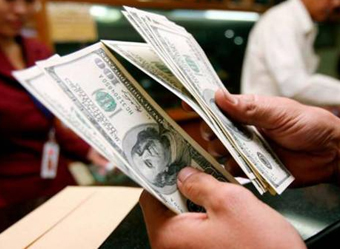The dollar held the bulk of its gains on Monday after an upbeat U.S. jobs report lifted it off 15-month lows, with data lined up this week seen as key to whether the greenback’s rebound could be sustained in the longer term.
The dollar, which briefly sank below 110.00 yen to a seven-week low last week, was steady at 110.695 yen after going as high as 111.050 on Friday.
The dollar index against a basket of six major currencies was a shade lower at 93.330 after climbing 0.75 percent on Friday. The rally pulled it away from 92.548, its lowest level since May 2016 marked on Wednesday.
The greenback had reached that 15-month trough after a series of weak U.S. indicators added to uncertainty about the Federal Reserve’s plan to start shrinking its $4.2 trillion bond portfolio and the pace of its rate hikes amid political turmoil gripping Washington.
But closely watched U.S. employment data released on Friday helped the dollar snap out of its downturn. Nonfarm payrolls increased by a bigger-than-forecast 209,000 jobs last month, while average hourly earnings increased 0.3 percent to match expectations after rising 0.2 percent in June. “The jobs report was able to halt the dollar’s bear trend for now. We can at least hope for the Fed to begin shrinking its balance sheet at the September meeting,” said Koji Fukaya, president of FPG Securities.
“The jobs report was able to halt the dollar’s bear trend for now. We can at least hope for the Fed to begin shrinking its balance sheet at the September meeting,” said Koji Fukaya, president of FPG Securities.
The euro inched up 0.2 percent to $1.1798 after losing 0.8 percent on Friday, to put some distance between a 2-1/2-year high of $1.1910 scaled earlier last week.
While the strong jobs data helped the dollar by keeping prospects of a December interest rate hike by the Fed alive, markets are looking for further evidence of robust fundamentals in order to firm up the U.S. currency’s upturn.
“This is going to be a crucial week for the dollar. The limited rise by the 10-year Treasury yield despite the strong payrolls shows that concerns towards slowing U.S. inflation still linger,” said Junichi Ishikawa, senior FX strategist at IG Securities in Tokyo.
“Data such as the producer and consumer price indexes may have to be better than expected to douse inflation concerns. Only then would the dollar reach a real turning point.”
U.S. producer price index numbers for July will be released on Thursday and the consumer price index figures are due on Friday.
The 10-year Treasury note yield stood at 2.267 percent, pulling back slightly from Friday’s high of 2.290 percent.
The Australian dollar was up 0.2 percent at $0.7944 having trimmed some of its losses after dropping about 0.7 percent last week against the broadly higher dollar.
The pound was little changed at $1.3055. Friday’s dollar surge deepened losses for sterling, which was already on the back foot after the Bank of England kept rates unchanged on Thursday and delivered a dovish message. It has slid sharply from a 13-month peak of $1.3267 set earlier last week.
Source: Reuters



